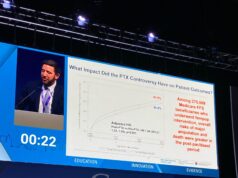By Luis Mariano Palena
Despite the initial success rate of endovascular treatment and stenting for superficial femoral artery (SFA) and popliteal artery lesions1, long-term results for stent use have not been favourable; in fact in-stent occlusion is a common and well-known complication in the SFA region2.
The options to treat in-stent occlusion are endovascular or open surgery intervention. Endovascular treatment, intended as a passage through the occluded stent, is the least invasive option and can lead to good technical and clinical results, but in cases of in-stent total and chronic occlusion crossing the occluded stent is very difficult or impossible and subintimal progression of the wire at the edge of the occluded stent is a frequent problem3,4. Retrograde trans-popliteal or infrapopliteal access followed by retrograde recanalisation and the SAFARI technique often lead to subintimal recanalisation too.
In these cases, direct stent puncture (DSP) is a technical strategy to recanalise the occluded stent in the SFA and popliteal artery. After local anaesthesia, antegrade access in common femoral artery is performed and 5F sheath positioned.
A total of 5,000 IU of heparin is administered. After several unsuccessful attempts to engage and cross the occluded stent through the antegrade access, with the patient in a supine position, under ultrasound and fluoroscopic guidance, a retrograde direct puncture of the occluded stent is performed (19-gauge no mandrinated needle); oblique projections checks are necessary to ensure that the needle tip is positioned precisely in the occluded stent lumen. A 0.035-in or a 0.018-in guidewire is inserted and a loop-shaped tip performed inside the occluded stents, a 4F sheath and a BER II catheter are inserted and retrogradely advanced into the stent; the loop-shaped tip of the wire avoids accidental extraluminal passing through of the stent struts.
Approaching the ostium of the SFA, the antegrade BER II catheter is engaged with the retrograde guidewire. Once successfully engaged, the antegrade BER II catheter is advanced to the distal sheath; a new 0.018-in guidewire is antegradely inserted and advanced beyond the sheath through the distal occluded edge and to a good-patency distal artery. After checking to ensure a good flow, flushing through the distal landed BER II, the catheter is retrieved, and a long catheter balloon (5 or 6mm in diameter) is inserted and inflated to nominal pressure for 5 minutes, previous recovery the retrograde distal sheath (PTA and haemostasis)4.
We have been accumulating experience with this technique and retrospectively reviewed 42 consecutive patients with critical limb ischemia who had occluded SFA stents treated over the past two years5. While the majority of the lesions—29 (69%)—could be recanalised through an antegrade access, 13 (31%) stents proved uncrossable with standard antegrade manoeuvres to engage the occluded device. However, ipsilateral antegrade access combined with retrograde direct in-stent puncture (DSP) was successful in opening an intraluminal path through the occluded stent followed by antegrade angioplasty. This combined approach was simple, safe, and did not increase the procedure time. There were no complications, such as bleeding, acute thrombosis, distal embolism, or haematoma at the in-stent puncture site. Over a mean 12-month follow-up (range 3–18), the primary patency rate of patients treated with the DSP technique was 92% at six months and 75% at 18 months by Kaplan-Meier analysis; no stent fractures have been seen.
We looked for variables that might influence the success of intraluminal stent recanalisation withthe antegrade vs. DSP techniques. The only factor we found was the distance from the SFA origin to the proximal edge of the occluded stent. If it was > 100 mm, subintimal passage of the guidewire in the SFA and stent was the likely outcome. A subintimal recanalisation and re-stenting, called ‘‘double-barrel restenting’’ was described6. This approach seems to be a temporary solution, though, because the original stent remains occluded and the second subintimal stent deployment could increase the risk of reocclusion and fracture involving both stents. Among the ever-growing toolbox of techniques for dealing with CTOs in native arteries, retrograde popliteal or tibial access in our experience very often leads to subintimal progression of the guidewire, so these approaches do not improve recanalisation success in occluded stents. The DSP technique is a new tool for recanalising in-stent occlusions that appear to be free of complications and can be particularly advantageous in patients who are not candidates for surgical bypass.
References:
- Norgen L, Hiatti WR, Dormandy JA, et al. TASC II Working group. Inter-Society Consensus for the management of Peripheral Arterial Disease (TASC II). Eur J Vasc Endovasc Surg. 2007;33(1):S1-S75.
- Schlager O, Dick P, Sabeti S, et al. Longsegment SFA stenting—the dark sides: in-stent restenosis, clinical deterioration, and stent fractures. J Endovasc Ther. 2005;12:676–684.
- Duterloo D, Lohle P and Lampmann L. Subintimal double-barrel restenting of an occluded primary stented superficial femorale artery. Cariovasc Intervent Radiol. 2007;30(3):474-476.
- Palena LM, Cester G, Manzi M. Endovascular treatment of in-stent occlusion: new technique for recanalization of long superficial femoral artery occlusion (Direct Stent Puncture Technique). Cardiovasc Intervent Radiol. 2012;35:418-421.
- Manzi M, Palena LM, Brocco E. Clinical results using the Direct Stent Puncture Technique to treat SFA in-stent occlusion.
- Duterloo D, Lohle P and Lampmann L. Subintimal double-barrel restenting of an occluded primary stented superficial femorale artery. Cariovasc Intervent Radiol. 2007;30(3):474-476.
Luis Mariano Palena, Interventional Radiology Unit, Foot & Ankle clinic,Policlinico Abano Terme, Padua, Italy













